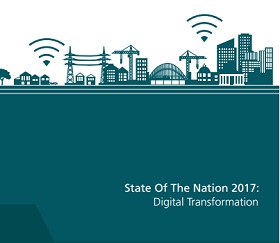State of the nation: Digital transformation
On 22 March 2017, ICE published their State of the Nation 2017 report, looking at how advances in digital technology and data are transforming how infrastructure is designed, delivered and operated.
Digital transformation is bringing benefits to clients and end users as well as unlocking economic growth and productivity across the UK.
State of the Nation 2017 discusses the practical steps industry and government need to take to maintain momentum and truly harness the benefits.
Guided by ICE's steering group, they talked to 350 organisations and individuals, asking them to identify the main blockers and enablers to infrastructure’s digital transformation.
The key recommendations of the report are as follows:
Unlock the productivity potential of digital transformation
- Digital transformation should be at the heart of the infrastructure pillar in government industrial strategy.
- The £23bn National Productivity Investment Fund should be targeted at digital transformation of both construction (digital delivery) and infrastructure (smart infrastructure) to increase capacity and performance of existing assets and networks.
- Regulatory frameworks across all infrastructure sectors should incentivise whole life investment decisions based on the needs of the end user.
Encourage a step change in organisational culture and leadership in industry
- ICE and other professional institutions must work with industry and government to ensure that people at all points in their career have the right skills to adapt.
- Clients, contractors and government should use infrastructure projects, big and small, as incubators for skills and innovation.
- Clients should insist that data is identified, collected, stored and shared in the right way by everyone working on a project as part of the procurement process.
Future proof our infrastructure networks
- Cyber and physical security considerations must be at the centre of industry thinking in order to keep up with evolving security threats.
- As infrastructure decisions are increasingly made at local level we need to invest in improving the quality of local asset data. This well help improve understanding of the interdependencies between different assets and how that changes with increased connectivity.
- The National Infrastructure Commission should set out a needs-based strategy to align energy and digital infrastructure policy.
You can download the report here.
This article was originally published here on 22 Mar 2017 by ICE. It was written by Kelly Forbes.
--The Institution of Civil Engineers
[edit] Related articles on Designing Buildings
- Achieving sustainable roads funding in England.
- Articles by ICE on Designing Buildings Wiki.
- Cyber security and engineering.
- Data and infrastructure productivity.
- Digital Built Britain.
- Digital communications and infrastructure dependencies.
- Digital technology.
- Digital transformation - engineers need to keep pace.
- Digital transformation - overcoming barriers.
- Digital transformation - what does it mean?
- Future skills for civil engineers.
- Golden Thread report published by CIOB and i3PT.
- How can we help achieve net zero?
- How to gain a competitive edge with digital technologies.
- How to make the digital revolution a success.
- Project 13 and World Economic Forum partnership.
- Ripe for transformation, ready for change?
- State of the nation: Devolution.
- State of the Nation 2020.
- UK BIM Alliance and CIOB join forces.
Featured articles and news
A change to adoptive architecture
Effects of global weather warming on architectural detailing, material choice and human interaction.
How big is the problem and what can we do to mitigate the effects?
Overheating guidance and tools for building designers
A number of cool guides to help with the heat.
The UK's Modern Industrial Strategy: A 10 year plan
Previous consultation criticism, current key elements and general support with some persisting reservations.
Building Safety Regulator reforms
New roles, new staff and a new fast track service pave the way for a single construction regulator.
Architectural Technologist CPDs and Communications
CIAT CPD… and how you can do it!
Cooling centres and cool spaces
Managing extreme heat in cities by directing the public to places for heat stress relief and water sources.
Winter gardens: A brief history and warm variations
Extending the season with glass in different forms and terms.
Restoring Great Yarmouth's Winter Gardens
Transforming one of the least sustainable constructions imaginable.
Construction Skills Mission Board launch sector drive
Newly formed government and industry collaboration set strategy for recruiting an additional 100,000 construction workers a year.
New Architects Code comes into effect in September 2025
ARB Architects Code of Conduct and Practice available with ongoing consultation regarding guidance.
Welsh Skills Body (Medr) launches ambitious plan
The new skills body brings together funding and regulation of tertiary education and research for the devolved nation.
Paul Gandy FCIOB announced as next CIOB President
Former Tilbury Douglas CEO takes helm.
UK Infrastructure: A 10 Year Strategy. In brief with reactions
With the National Infrastructure and Service Transformation Authority (NISTA).
Ebenezer Howard: inventor of the garden city. Book review.
Airtightness Topic Guide BSRIA TG 27/2025
Explaining the basics of airtightness, what it is, why it's important, when it's required and how it's carried out.























